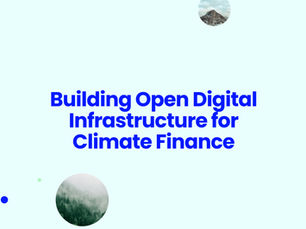
Blockchain in Action: Advancing Carbon Markets with Digital Innovation – Insights from the GBBC Sustainability Summit
Global Blockchain Business Council (GBBC) co-hosted the Sustainability Summit alongside Blockchain x Climate (BxC) and Microsoft on Tuesday, September 24th. The event was an incredible meeting of minds—bringing together Web3 pioneers, traditional enterprises, startups, and organizations from across sectors to explore how blockchain and innovation can help us achieve climate-related Sustainable Development Goals.
Andrew Bonneau, Managing Director at Carbonmark, spoke at the summit, sharing insights on how digital carbon markets create impactful pathways towards a more sustainable future.
Couldn’t make it to New York this time? No worries, here is the summary of the panel “Blockchain in Action: Advancing Carbon Markets with Digital Innovation.”

Summarized Transcript
Diana Barrero Zalles, Head of Research and Sustainability at Global Blockchain Business Council: I am so excited to have Marcus, Drew, and Austin here.
We are here to explore use cases of digital carbon markets, and a report from the working group under BXC is coming out next week, to which many of you contributed. We’ll discuss digital solutions and the findings you’ve all been working on at the forefront of creating the next generation of digital carbon markets.
Diana: I’m Diana, for those who don’t know me. I run research and sustainability at GBBC. It's a huge pleasure to be with Marcus, Drew, and Austin. I’ll let each of you introduce yourselves, and then we'll get started.
Marcus Levine, Contributor at KlimaDAO: Hey everybody, I’m Marcus. It's great to be here with you. I’m a contributor at KlimaDAO, where we’re using blockchain technology to solve problems on the demand side of the carbon market by creating increased liquidity and deploying capital to finance new projects all over the world that are using digital MRV and other innovative technology-based approaches to issue and verify carbon credits.
Andrew Bonneau, Managing Director at Carbonmark: Hey, everyone, I’m Drew, one of the co-founders of KlimaDAO back in the day. This all started for me with blockchain a couple of years ago when I had another company doing emissions analysis. Originally, we were looking at the carbon footprint of various blockchains. From that work, we realized that technology could provide a number of interesting solutions to link what has historically been a fragmented market. So, we co-founded KlimaDAO as an experiment, bringing a lot of energy into the space and leveraging blockchain technology. Now, I’m the Director at Carbonmark, where we work to link various carbon registries and leverage smart contracts to make these assets programmable on the blockchain, building automation around the procurement and use of environmental assets.
Austin Wade Smith, Executive Director at Regen Foundation: Hi, everyone. I’m Austin Wade Smith, Executive Director of Regen Foundation, the nonprofit arm of the larger Regen Network. Our focus is on the origination and innovation of high-integrity eco-credits and the evolution of biodiversity and carbon credits in the larger marketplace. At Regen Foundation, I oversee governance and ownership at the grassroots level, empowering regenerative communities to govern the Regen Network. My focus is on ensuring grassroots stakeholders play a role in maintaining the overall protocol infrastructure and securing regenerative action sustainably.
Diana: Marcus, what got you into the carbon markets in the first place? What inspired you, and what need did you see that wasn’t being filled?
Marcus: I heard about KlimaDAO on the Bankless podcast in September 2021. I was excited by the opportunity to apply my technical skillset, particularly in data science and engineering, to solve sustainability problems. So much information was buried in PDFs, and opaque market data was traded over email. KlimaDAO aimed to bring this market activity out of the shadows, using blockchain to surface some of that information. We built a dashboard that showed which projects had been brought on-chain, how many transactions occurred, and how many credits were retired — making valuable market data publicly available and easily accessible.
Drew: Marcus’s story resonated with me as I was also involved in the early days of KlimaDAO. My journey began about eight years ago in graduate school, working with a company leveraging drone platforms to measure ecosystem services. Eventually, we focused on carbon markets. After founding my own company, we realized blockchain’s potential to automate processes like purchasing and retiring credits. However, we ran into roadblocks, like registries without the API solutions needed for automation. That’s why we co-founded KlimaDAO — to build the necessary tools for these processes. Fast forward, Carbonmark now simplifies blockchain interfacing for users, allowing them to manage assets without traditional web3 wallets, facilitating a smoother user experience for carbon credit transactions.
Austin: Regen Foundation focuses on empowering communities by rewarding regenerative ecological efforts. We’re enabling communities involved in planting, monitoring, and other regenerative actions to own and govern the network. Our work ensures that grassroots communities have the governance structures to define what high-quality eco-credits should look like based on their bio-regional and cultural contexts.
Diana: There’s been a lot of progress in carbon markets, but also challenges like ensuring carbon credits make a positive environmental impact. How do digital carbon markets address issues like double-counting and traceability?
Marcus: Double counting has been a significant issue, with reliance on PDFs as proof of credit consumption. Blockchain technology solves this by offering immutable, verifiable transaction data through public ledgers. Instead of relying on PDFs, digital carbon markets now share unique, immutable links that cannot be tampered with. This also reduces costs and time for carbon credit transactions, making the market more accessible.
Drew: Programmatic retirement is key. By leveraging blockchain’s transparency and immutability, we can automatically issue and retire carbon credits using data collected from digital monitoring and verification systems (DMRV). We are developing tools that allow full traceability and transparency from generating carbon credit to its final use. This creates a trusted ecosystem for tracking and verifying all steps in the carbon credit lifecycle.
Diana: Austin, how does your work at Regen Foundation ensure that carbon markets can drive both environmental and social benefits, particularly in the global south?
Austin: We aim to ensure that regenerative communities, especially those in the global south, aren’t alienated by the economic systems we build. Our model allows communities on the ground to define high-integrity eco-credits in ways that reflect their bio-regional and cultural contexts. This empowers them economically and ensures that the environmental credits issued don’t undermine the communities responsible for generating the underlying impact.
Diana: Thank you so much, everyone! This was an insightful discussion. Unfortunately, we’re out of time, but thanks again to Marcus, Drew, and Austin!
If you want to catch up and view the full programming and individual sessions, watch the live-stream recording here.






